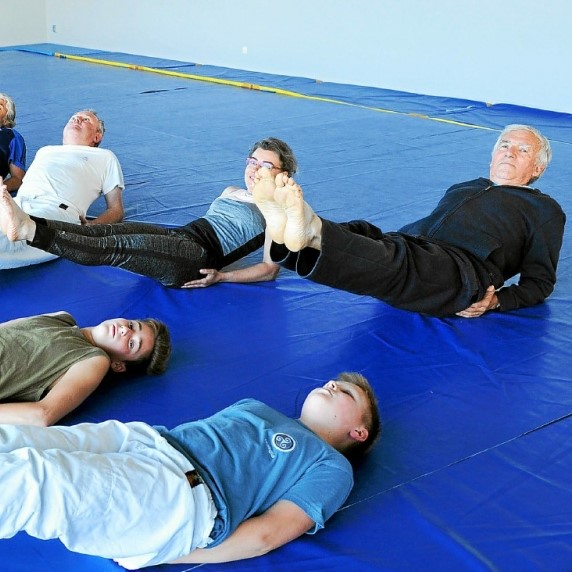
Why Has Modern Pilates Become So Static?
When most people think of Pilates today, they imagine lying on a mat, lifting their legs, or holding a posture for long counts. Core strength, stability, and toned abs — that’s the promise in nearly every commercial studio.
But here’s the question: is that really what Joseph Pilates created?
Joseph Pilates’ Original Vision
Joseph Pilates called his method Contrology. It wasn’t meant to be a sequence of isolated abdominal exercises. It was a whole-body system for natural movement: breathing, rolling, crawling, standing, walking, even preparing the body to fall safely.
In Return to Life Through Contrology (1945), he made his vision clear:
“Contrology develops the body uniformly, corrects wrong postures, restores physical vitality, invigorates the mind, and elevates the spirit.”
This was not about static repetitions. It was about learning to move with the grace and resilience of everyday life.
Why Did Pilates Become Static?
So why do most studios today look so different?
- Commercialisation – After Pilates’ death in 1967, his method was absorbed by the fitness industry. Group mat classes became the easiest way to market and standardise. Rolling, crawling, or hopping were quietly left out.
- Safety Concerns – Studios wanted to avoid risk. Static core work is considered “safer” than falling drills or hopping sequences.
- Fitness Trends – In the 1980s–90s, Pilates was popularised as a way to get “flat abs” and long, lean muscles. The aesthetic goal overshadowed the functional one.
- Client Expectations – People walking into a Pilates studio today expect yoga-like or ab-focused work. Studios meet those expectations.
The result? A stripped-down version of Pilates that often ignores its roots in dynamic, natural movement.
What Pilates Actually Said
Rolling and Falling
Pilates explicitly included rolling in his original mat repertoire:
“Rolling like a ball keeps the spine supple and strengthens the abdominal muscles… It teaches control, balance, and the art of absorbing shocks.”
(Return to Life Through Contrology, 1945, pp. 24–25)
This is precisely what Art of Falling work develops today — rolling as preparation for life’s unexpected slips.
Crawling and Quadruped Patterns
Pilates urged us to study animals and infants to recover lost natural movement:
“Look at the animals in the wild. They move with grace, agility, and natural rhythm. It is this natural suppleness and control which we must regain.”
(Your Health, 1934, p. 27)
That is why crawling exercises reappear in my classes — they reconnect primitive reflexes, improve coordination, and return us to this natural suppleness.
Running and Hopping
Dynamic footwork was part of his repertoire:
“Running” and “Skipping” stimulate circulation, strengthen the arches of the feet, and invigorate the body. They demand rhythm, coordination, and vitality.”
(Return to Life Through Contrology, 1945, exercise section)
This is the same purpose behind light hopping and running drills: not cardio, but balance and rhythm training.
Breathing and Lung Awareness
Pilates gave breathing pride of place:
“Breathing is the first act of life, and the last… Above all, learn how to breathe correctly. Squeeze every atom of air from your lungs until they are almost as free of air as a vacuum.”
(Return to Life Through Contrology, 1945, pp. 13–15)
Your lung awareness practices refine this principle with modern somatic methods.
Functional Everyday Movement
Finally, Pilates warned against reducing his work to bodybuilding or aesthetics:
“Contrology is not a system of haphazard exercises designed to produce only bulging muscles. Rather, it was conceived to limber and stretch muscles and ligaments so that your body will be as supple as that of a cat, not muscular like a brewery-truck horse.”
(Return to Life Through Contrology, Preface)
This is exactly why we combine fall-prevention, crawling, hopping, and rolling: to build cat-like resilience for daily life.
Taiso: The Missing Link
Taiso (体操) is the Japanese art of natural movement. Practised for centuries by farmers and workers, it wasn’t a sport but a way to keep the body supple, resilient, and adaptable.
Like Pilates’ Contrology, Taiso emphasises:
- Crawling, rolling, hopping, and standing up as essential life-skills.
- Coordination of posture, eyes, and breathing through primitive reflexes.
- Balance and confidence through natural patterns rather than isolated muscles.
Bringing Taiso and Pilates together makes perfect sense: both were designed to prepare people for real life, not just the studio.
A Living Method
Pilates was never meant to be static. It was meant to be alive, adaptable, and practical — a way to return the body to its natural grace. By blending Joseph Pilates’ own principles with Taiso and modern knowledge of reflex integration and fall-prevention, we bring the method back to its roots: preparing people to move better, live better, and fall more safely.
Bibliography
- Pilates, J. H. (1934). Your Health. New York: Presentation Dynamics.
- Pilates, J. H. (1945). Return to Life Through Contrology. New York: J.J. Augustin.
- Gallagher, S. P., & Kryzanowska, R. (2000). The Joseph Pilates Archive Project: Return to Life Through Contrology (Reprint). Incline Village, NV: BainBridge Books.
- Isacowitz, R. (2014). Pilates. Champaign, IL: Human Kinetics.
- Latey, P. (2001). “The Pilates Method: History and Philosophy.” Journal of Bodywork and Movement Therapies, 5(4), 275–282.
- Wells, C., Kolt, G. S., Bialocerkowski, A., & Matyas, T. (2012). “The History of Pilates: A Literature Review.” Complementary Therapies in Medicine, 20(4), 253–262.